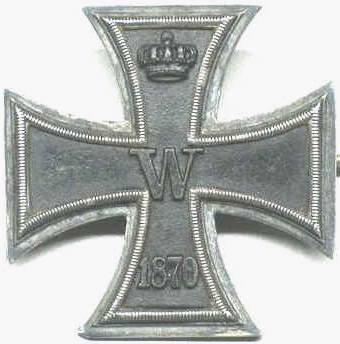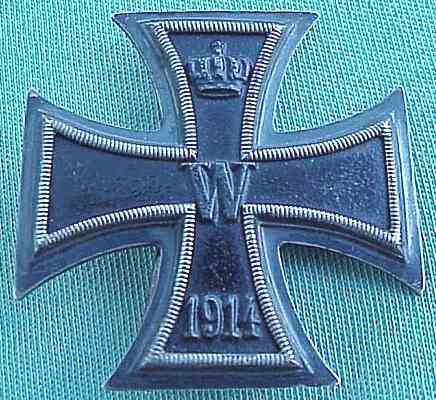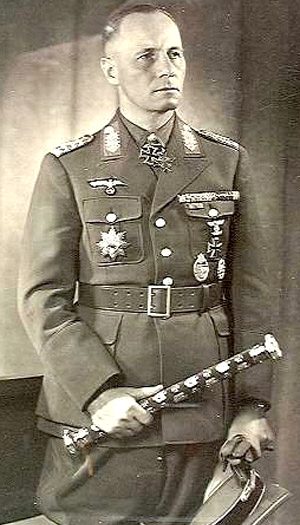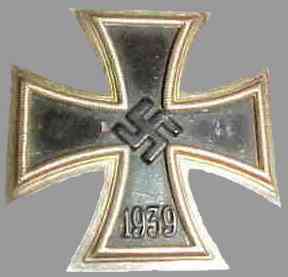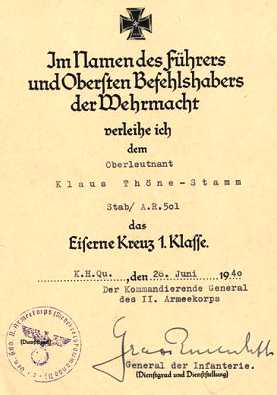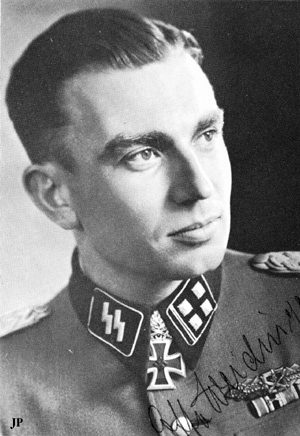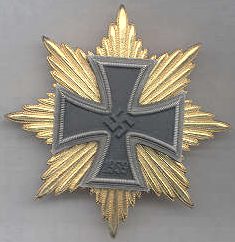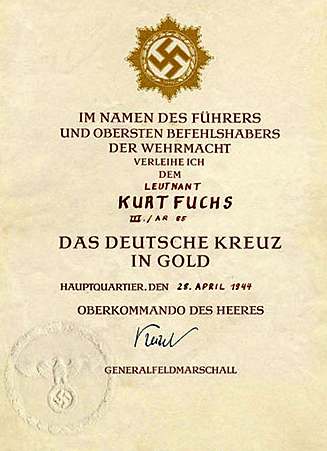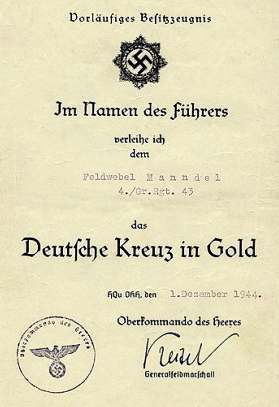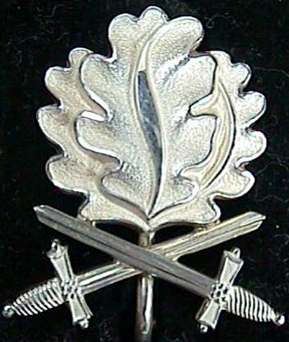|
THE IRON CROSS
|
||
Sometimes erroneously called the Maltese cross, the Iron Cross (German: das Eiserne Kreuz) is a military decoration of the Kingdom of Prussia, and later of Germany, which was established by King Friedrich Wilhelm III of Prussia and first awarded on 10 March 1813. The Iron Cross is only awarded in wartime. In addition to the Napoleonic Wars, the Iron Cross was awarded during the Franco-Prussian War, and the First and Second World Wars. The Iron Cross has not been awarded since May 1945. It is a military decoration only — civilians are ineligible.
The Iron Cross originally was the symbol of the Teutonic Knights (a heraldic cross pattée) and the cross design (but not the specific decoration) has been the symbol of Germany's armed forces (now the Bundeswehr) since about 1870.
1870 Iron Cross
Design
The Iron Cross (a black four-pointed cross with white trim, with the arms widening towards the ends, similar to a Maltese Cross) was designed by the neoclassical architect Karl Friedrich Schinkel and reflects the cross borne by the Teutonic Knights in the 14th century, which was also the emblem of Frederick the Great. When the Quadriga of the Goddess of Peace was retrieved from Paris at Napoleon's fall, the Goddess was re-established atop Berlin's Brandenburg Gate. An Iron Cross was substituted for her laurel wreath, making her into a Goddess of Victory.
In contrast to many other medals, the Iron Cross has a very simple design, unadorned, and is made from relatively cheap and common materials. It was traditionally cast in iron, although in later years, the decoration was cast in zinc and aluminium.
The ribbon for the 1813, 1870, and 1914 Iron Cross (2nd Class) was black with two thin white bands. The noncombatant version of this award had the same medal, but the black and white colors on the ribbon were reversed.
Since the Iron Cross was issued over several different periods of German history, the Iron Cross is annotated by a year numeral to indicate the era in which the Iron Cross was issued: so, for example, an Iron Cross from the First World War is annotated with the year numeral "1914", while the same decoration from the Second World War is annotated with the numeral "1939". The reverse of the 1870, 1914, and 1939 series Iron Crosses have the year "1813" annotated on the lower arm, symbolizing the year the award was first created.
It was also possible for a holder of the 1914 Iron Cross to be awarded a higher grade of the 1939 Iron Cross. A reward of the first or second class was also possible. In such cases a "1939 Clasp" ("Spange") would be worn on the original 1914 Iron Cross. (A similar award was made in 1914 but was quite rare, since there were few in service who held the 1870 Iron Cross.)
Iron Cross 1st Class 1914
Early awards
The Iron Cross was founded on 10 March 1813 in Wrocław and awarded to soldiers during the Wars of Liberation against Napoleon. The Prussian King Wilhelm I authorized further awards on 19 July 1870, during the Franco-Prussian War. Recipients of the 1870 Iron Cross who were still in service in 1895 were authorized to purchase a 25-year clasp consisting of the numerals "25" on three oak leaves. The Iron Cross was reauthorized by Kaiser Wilhelm II on 5 August 1914, at the start of the First World War. During these three periods, the Iron Cross was an award of the Kingdom of Prussia, although given Prussia's preeminent place in the German Empire formed in 1871, it tended to be treated as a generic German decoration.
The 1813, 1870 and 1914 Iron Crosses had three grades:
The Grand Cross was intended for senior Generals of the German Army. An even higher decoration, the Star of the Grand Cross of the Iron Cross, was only awarded twice, to Prince von Blücher in 1813 and to Field Marshal Paul von Hindenburg in 1918. A third award was planned for the most successful German general during the Second World War, but was not made after the defeat of Germany in 1945.
Erwin Rommel Iron Cross with Oak Leaves
The Iron Cross 1st Class and the Iron Cross 2nd Class were awarded without regard to rank. One had to already possess the 2nd Class in order to receive the 1st Class (though in some cases both could be awarded simultaneously). The egalitarian nature of this award contrasted with most other German states (and indeed many other European monarchies), where military decorations were awarded based on the rank of the recipient. For example, in Bavaria officers would receive various grades of that Kingdom's Military Merit Order (Militär-Verdienstorden), while enlisted men would receive various grades of the Military Merit Cross (Militär-Verdienstkreuz). Prussia did have other orders and medals, however, which were awarded on the basis of rank, and even though the Iron Cross was intended to be awarded without regard to rank, officers and NCOs were more likely to receive it than junior enlisted soldiers.
In the First World War, approximately 5 million Iron Crosses of the lower grade (2nd Class) were issued, as well as around 218,000 of the higher grade (1st Class). Exact numbers of awards are not known, since the Prussian archives were destroyed during the Second World War. The multitude of awards reduced the status and reputation of the decoration. One of the most famous holders of the 1914 Iron Cross 1st Class was Adolf Hitler (which was unusual as very few holders of the 1914 Iron Cross 1st Class were enlisted soldiers: Hitler held the rank of Gefreiter, or Lance Corporal).
Second World War
Adolf Hitler restored the Iron Cross in 1939 as a German decoration (rather than Prussian as in earlier incarnations), continuing the tradition of issuing it in various grades. The Iron Cross of the Second World War was divided into three main series of decorations with an intermediate category, the Knight's Cross of the Iron Cross, instituted between the lowest, the Iron Cross, and the highest, the Grand Cross. The Knight's Cross replaced the Prussian Pour le Mérite. Hitler did not care for the Pour le Mérite, as it was a Prussian order which could only be awarded to officers. The ribbon of the medal (2nd class and Knight's Cross) was different from the earlier Iron Crosses in that the color red was used in addition to the traditional black and white (black and white were the colors of Prussia, while black, white and red were the colors of Germany). Hitler also created the War Merit Cross as a replacement for the noncombatant version of the Iron Cross.
Iron Cross First Class 1939
Iron Cross
The standard 1939 Iron Cross was issued in the following two grades:
The Iron Cross was awarded for bravery in battle as well as other military contributions to a battlefield environment.
The Iron Cross 2nd Class came with a ribbon and was worn in one of three different methods:
The Iron Cross First Class was a pin-on medal with no ribbon and was worn centered on a uniform breast pocket.
The Iron Cross was a progressive award, with second class having to be earned before the first class and so on for the higher degrees.
It is estimated that some 2.3 million Second Class Iron Crosses were awarded in the Second World War, and 300,000 in the First Class. Two Iron Cross First Class recipients were women, one of those being test pilot Hanna Reitsch.
Knight's Cross of the Iron Cross
The Knight's Cross of the Iron Cross (German: Ritterkreuz des Eisernen Kreuzes, often simply Ritterkreuz) recognized extreme battlefield bravery or successful leadership. The Knight's Cross was divided into five degrees:
In total, 7,313 awards of the Knight's Cross were made, but only 883 received Oak Leaves and 159 received Oak Leaves and Swords (including Japanese admiral Isoroku Yamamoto, posthumously). Only 27 men were ever awarded the Diamonds grade of the Knight's Cross (10 ace pilots, 2 U-boat captains, 1 colonel, 14 generals and field marshals), and Hans-Ulrich Rudel was the only recipient of the Knight's Cross with Golden Oak Leaves, Swords, and Diamonds.
The Knight's Cross with Oakleaves and Swords was the next higher grade of the Knight's Cross above the Knight's Cross with Oakleaves, and as such, was an even more highly regarded award than all those previous. This grade of the RK was actually instituted after the first award of it was presented! The number awarded during WWII, 160, is a testiment to the even greater honor attached to this award. Like the Knight's Cross with Oakleaves, the RK with Oakleaves and Swords could also be awarded to foreigners and was also awarded to commanders in recognition of the valor of the unit they commanded. Of the 160 holders of the RK with Oakleaves and Swords, 14 are known to be alive in 1999 and of the 159 German holders, 38 (24%) are known to have been killed in action or are listed as missing in action during WWII.
Otto Weidinger wearing Iron Cross with Oak Leaves and Swords
Grand Cross of the Iron Cross (1939)
Like the Knight's Cross, the Grand Cross (Großes Kreuz) was also worn suspended from the collar. The only recipient of the Grand Cross during the Second World War was Hermann Göring, who was awarded the decoration on July 19, 1940. The medal is in effect an oversized Knight's Cross. It had the same overall characteristics as the Knights Cross but was much larger, measuring 63 mm in width as opposed to about 44 mm for the Iron Cross and 48.5 mm for the Knight's Cross. It was originally intended to have outer edges lined in gold, but this was changed to silver before the award was presented.
The Grand Cross was worn with a 57 mm wide ribbon bearing the same colors as the Knights Cross and 2nd Class ribbons. The award case was in red leather with the eagle and the swastika outlined in gold.
The Grand Cross was not a bravery award. It was reserved solely for General Staff officers for "the most outstanding strategic decisions affecting the course of the war". Hermann Göring received the Grand Cross for his command of the Luftwaffe during the successful 1940 campaign against France, Belgium, and the Netherlands (at the same time as he was promoted to Reichsmarschall of the Greater German Reich).
The original Grand Cross that was presented to Göring (personally by Adolf Hitler) was destroyed during an air raid on his Berlin home. Göring had extra copies made, one of them with a platinum frame which he was wearing at the time of his surrender to the allies in 1945.
Several times in official photographs, Göring can be seen wearing his Pour le Mérite, his Knights Cross, and Grand Cross around his neck at the same time.
Star of the Grand Cross of the Iron Cross 1939
Star of the Grand Cross of the Iron Cross (1939)
This award was manufactured, but it was never awarded to any recipient. The only known example was found by Allied occupation forces at the end of the war, and was eventually added to the West Point military collection. The design was based on the 1914 version of the Star of the Grand Cross, but with the 1939 Iron Cross as the centerpiece. This award was meant to be worn like the Iron Cross First class (as a breast star). Like the Grand Cross of the Iron Cross, this award was not intended to be bestowed for bravery. It was intended to be bestowed upon the most successful General officer at the conclusion of the war.
Side features of the Iron Cross and entitlements
Officers awarded the Iron Cross were given entitlements and often wore signifying articles, for example, an Iron Cross signet ring or cloth Iron Cross which could be affixed to clothing. Also, during the Nazi period, those attaining more than one award, for example, an officer who had attained an Iron Cross 1st class, an Iron Cross 2nd class and the Knight's Cross of the Order of the Iron Cross with the Oak Leaves, were entitled to wear a pin which exhibited three Iron Crosses with an exaggerated swastika, thereby consolidating the awards.
Post-WWII
The Iron Cross is solely a wartime decoration and has not been awarded since the end of the Second World War. German law prohibits the wearing of a swastika, so in 1957 the West German government issued replacement Iron Crosses to World War II veterans with the swastika replaced by an Oak Leaf Cluster, similar to the Iron Crosses of 1813, 1870 and 1914.
The Iron Cross was used as the symbol of the German Army until 1915, when it was replaced by a simpler Greek cross. However, on 1 October 1956 the President of Germany, Theodor Heuss gave directions to use the Iron Cross as the official emblem of West Germany's Bundeswehr. Today, after German reunification in the colours blue and silver, it is the symbol of the "new" Bundeswehr. However, this design does not replace the traditional black Iron Cross and can be found on all armoured vehicles, tanks, naval vessels, planes and even UAV's of the German forces.
Use in popular culture
In 1977 Sam Peckinpah directed a film entitled Cross of Iron, based on a novel of the same name, which told the story of a veteran German sergeant on the Russian Front, including his relationship with a commanding officer more interested in getting his own Iron Cross than in taking care of his men. Cross of Iron has also been the title of at least three separate wargames; one released in 1977 as part of the Squad Leader series, another as a magazine game in Strategy & Tactics Magazine, and a third as a computer game for the PC.
The Iron Cross has also been appropriated by several American subcultures after WWII. In particular, motorcycle clubs, surfing and skateboarding culture, fans of heavy metal music, neo-Nazis, and the hot rod and custom car cultures use the symbol in various forms.
The villainous character Nyder in the Doctor Who story Genesis of the Daleks wears an Iron Cross on his uniform in early episodes (the story is in six parts), but it disappears, having been removed later in the recording process as the Nazi parallel was deemed to be too heavy handed.
In The Simpsons episode "Natural Born Kissers" (referred to in the UK broadcasts as "Margie, May I Sleep With Danger"), Abe Simpson mentions he won an Iron Cross for his (botched) work in clearing roads of German mines in WWII.
Professional wrestler Triple H has used the design on much of his merchandise since 2000.
Because of its popularity the Iron Cross, especially the 1st Class medal, has been heavily reproduced. Buyers should confirm authenticity before purchase.
Close up of Oak Leaves and Swords
References
CYBER WARS by Jameson Hunter © 2014
|
||
|
This website is Copyright © 1999 & 2018. All rights reserved. Max Energy Limited is an educational charity.
|
